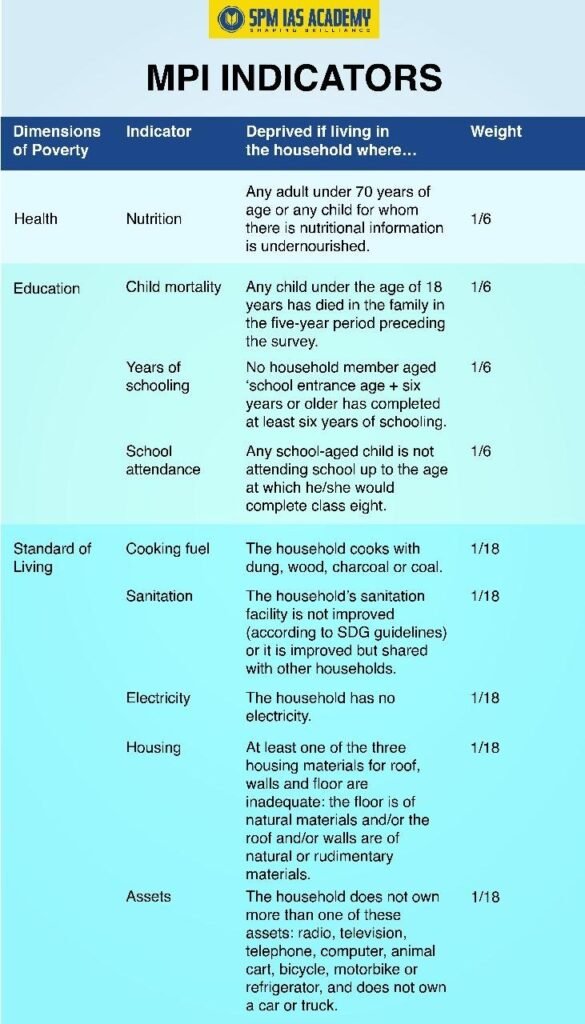“Unlike traditional income-based poverty measures, the MPI captures the complex realities of deprivation affecting people’s lives in multiple dimensions.”
In this article we will discuss the recently published Global Multidimensional Poverty Index, 2025 and its key findings. This will help the aspirants of UPSC CSE and APSC CCE. It is relevant for GS Paper 2 (Governance, Welfare Schemes), GS Paper 3 (Inclusive Growth, Poverty) and Essay.

What is Global Multidimensional Poverty Index?
- UNDP and the Oxford Poverty and Human Development Initiative (OPHI) jointly release the Global Multidimensional Poverty Index (MPI).
- In 2010, for the first time, OPHI and UNDP developed Global Multidimensional Poverty Index.
- It provides a holistic measure of poverty by looking beyond income. It captures the multiple deprivations people face in their daily lives.
- It measures poverty through three core dimensions with ten sub indicators of deprivation.

About Global Multidimensional Poverty Index, 2025
- The Global Multidimensional Poverty Index, 2025 includes new data from 13 countries.
- Secondly, Global Multidimensional Poverty Index, 2025 encompasses 109 countries, representing 6.3 billion people. Of this population, 18.3% (1.1 billion) experience acute multidimensional poverty. Among them, 43.6% (501 million) live in severe poverty, being deprived in half or more of the weighted MPI indicators.
- As per the index, out of a global population of 6.3 billion, 1.1 billion people live in severe multidimensional poverty, with more than half being children.
- Common deprivations include a lack of clean cooking fuel, housing, sanitation, nutrition, and electricity.
What is Multidimensional Poverty?
- It refers to a condition in which individuals or households experience multiple and overlapping deprivations. It goes beyond income poverty.
- It encompasses a lack of access to essential aspects of well-being—such as health, education, living standards, nutrition, and sanitation.
What are the Indicators of Global Multidimensional Poverty Index, 2025?

Key Findings of Global Multidimensional Poverty Index, 2025?
- The poorest people are young, rural and in places lagging on human development:
- Across 109 countries, 1.1 billion of the world’s 6.3 billion people live in multidimensional poverty.
- About 740 million poor people, representing 64.5% of the total, live in middle-income countries.
- Moreover, out of 1.1 billion poor people, around 887 million reside in subnational regions exposed to at least one of four climate hazards: extreme heat, drought, floods, or air pollution.
- Furthermore, of the 887 million poor people exposed to at least one climate hazard, 309 million live in subnational regions facing three or four concurrent hazards.
- Notably, approximately 27.8% of all children live in multidimensional poverty which is more than twice the adult rate of 13.5%. These 586 million children make up over half of the 1.1 billion people experiencing multidimensional poverty.
- In addition, more than 1 billion poor people live in countries with low or medium Human Development Index (HDI) levels. It accounts for roughly 90.5% of the global poor.
- Approximately 83.2% of the world’s poor—565 million in sub-Saharan Africa and 390 million in South Asia—reside in just these two regions.
- Despite comprising just 54.9% of the total population, rural areas host 83.5% of all multidimensionally poor people.
- Cooking fuel, housing, sanitation and nutrition remain common deprivations:
- Most multidimensionally poor people lack clean cooking fuel (970 million), adequate housing (878 million) and adequate sanitation (830 million).
- Around 635 million poor people live in households where at least one person is undernourished.
- Around 581 million poor people live in households where no one has completed six years of schooling; 487 million are in households where one or more children are out of school.
- Progress in reducing poverty remains uneven:
- Among 88 countries with harmonized trend data, 76 have seen MPI declines in at least one period, showing reductions in poverty.
- Of 26 countries with data ending in 2021–2022 or later, only 16 recorded statistically significant reductions in MPI and poverty, with Benin, Cambodia, and Tanzania showing the fastest absolute declines.
- In addition, only 6 of 91 subnational regions with recent trend data (2018–2022 or later) achieved significant poverty reduction.
- Climate hazards are more common than not for the poor:
- Of the 1.1 billion poor people, 887 million live in regions experiencing at least one of four climate hazards: high heat, drought, floods and air pollution. They include 608 million exposed to high heat, 577 million to air pollution, 465 million to floods and 207 million to drought.
- Out of 1.1 billion poor people, 887 million live in regions affected by at least one of four climate hazards: high heat, drought, floods, and air pollution. This includes 608 million exposed to high heat, 577 million to air pollution, 465 million to floods, and 207 million to drought.
- Many poor people face overlapping climate hazards: 651 million face two or more hazards and 309 million people three or four.
- Some 72.2 percent of poor people who are exposed to any climate hazard live in middle-income countries (641 million) and 61.8 percent in lower-middle-income countries (548 million).
- Although upper-middle-income countries have fewer poor people, 91.1% (93 million) face at least one climate hazard, compared with 61.3% in low-income countries.
- South Asia has driven global poverty reduction since 2005–2006, yet almost all poor people (99.1%) are exposed to at least one climate hazard, with 59% (226 million) facing three or four hazards.
The Overlapping Burden of Climate Change and Poverty:
Children Bear The Greatest Burden:
- Children under 18 make up 33.6% of the population. They are 51% of those in multidimensional poverty (586 million of 1.1 billion).
- Among children, 27.8% live in multidimensional poverty, over twice the adult rate of 13.5%.
- The youngest children (0–9 years) are most affected, accounting for 33.1% of all multidimensionally poor people.

Middle-income countries: A hidden epicentre of multidimensional poverty:
- About 740 million poor people (64.5% of 1.1 billion) live in middle-income countries, while low-income countries host 408 million (35.5%).
- Nearly all poor people in Europe, Central Asia, Latin America, the Caribbean, East Asia & the Pacific, and South Asia, reside in middle-income countries.
- In sub-Saharan Africa, over a third of the poor (224 million, 39.8%) live in middle-income countries.
Where Poverty Hits Hardest—Stark Geographical Divides:
- Sub-Saharan Africa and South Asia together account for 83.2% of all multidimensionally poor people worldwide.
- Sub-Saharan Africa, with 18.7% of the 6.3 billion population, houses nearly half of all people in acute multidimensional poverty.
- South Asia comprises 34% of the global multidimensionally poor, totaling 390 million people.

Compounding hardships: How climate hazards and poverty overlap:
- Poor people disproportionately experience climate hazards, a reality that threatens to derail efforts to eliminate poverty.
- Impoverished households are especially exposed to climate shocks as many depend on high-risk sectors such as agriculture and informal labour.
- Nearly 80 percent of poor people face climate hazards.
- This report examines four key climate hazards: high heat, drought, floods and air pollution. Across the 108 countries, 78.8 percent are in areas facing at least one of the four climate hazards.
- Globally, most multidimensionally poor people already live directly exposed to climate hazards.
- Countries in South Asia and sub-Saharan Africa consistently emerge as global hotspots for compounding hardships.
Despite poverty reduction, South Asia faces climate challenges:
- Except for Afghanistan, South Asia has made strong progress in poverty reduction. In India, poverty fell from 55.1% in 2005–2006 to 16.4% in 2019–2021. It lifted roughly 414 million people out of poverty.
- However, remaining poor populations face severe climate risks. Around 99.1% (380 million) are exposed to at least one hazard, 91.6% (351 million) to two or more, and 59% (226 million) to three or four hazards annually.
Lower-middle-income countries are most exposed:
- Around 246 million poor people (61.3%) experience at least one hazard.
Data related to India in Global Multidimensional Poverty Index, 2025:

Indian Government Efforts and Schemes Addressing Multidimensional Poverty:
- Poverty Reduction:
- Firstly, India lifted 415 million people out of multidimensional poverty between 2005–06 and 2019–21 (UNDP).
- Secondly, according to a NITI Aayog discussion paper (Jan 2024), 248.2 million people escaped multidimensional poverty between 2013–14 and 2022–23, with the headcount ratio dropping from 29.17% to 11.28%.
- In addition, the government aims to reduce multidimensional poverty below 1% and achieve SDG Target 1.2 (halving poverty) well before the 2030 deadline.
- Social Protection Schemes
- India has implemented large-scale programs targeting key MPI dimensions:
- Health & Nutrition: Ayushman Bharat, Poshan Abhiyan.
- Living Standards: Pradhan Mantri Awas Yojana (housing), Jal Jeevan Mission (drinking water), Pradhan Mantri Ujjwala Yojana (cooking fuel).
- Livelihoods: Mahatma Gandhi National Rural Employment Guarantee Act (MGNREGA) (PIB, 2024).
- India has implemented large-scale programs targeting key MPI dimensions:
- Climate Action and Legal Framework
- Firstly, National Action Plan on Climate Change (NAPCC): Comprises eight national missions promoting sustainable development, including climate-resilient agriculture.
- Secondly, Supreme Court Judgement: Recognizes the right to be free from adverse effects of climate change as a fundamental right under Article 21 (right to life) and Article 14 (equality).
Policy Implications of Global Multidimensional Poverty Index, 2025:
- It urges the governments to adopt a multisectoral approach that links health, education, housing, and environmental sustainability instead of relying solely on income-based poverty programs.
- This Index helps policymakers identify the most deprived regions and groups, allowing more efficient use of welfare budgets and social protection schemes.
- With the 2025 report overlaying climate hazards and poverty data, policies must now combine poverty alleviation with climate adaptation and resilience-building.
- It encourages countries to strengthen national data systems for better measurement of multidimensional poverty, ensuring timely, evidence-based interventions.
- The MPI supports Sustainable Development Goal (SDG) 1 (No Poverty) and fosters global partnerships to tackle shared vulnerabilities and inequalities.
Why the Global Multidimensional Poverty Index, 2025 is crucial?
- The Global Multidimensional Poverty Index, 2025 maps climate hazards against poverty data for the first time.
- It shows that most poor people face at least one climate hazard, often several.
- Countries with high multidimensional poverty will experience the sharpest temperature rise by century’s end.
- The report warns that climate and poverty risks will intensify, demanding urgent joint action.
Conclusion
As Amartya Sen rightly said, “Poverty is not just the lack of money; it is the lack of capability to live a decent life”, the Global Multidimensional Poverty Index, 2025 underlines this truth by revealing how deprivation extends far beyond income. It links poverty data with climate vulnerability and highlights the urgent need for integrated solutions addressing health, education, environment, and human dignity together.
Eradicating poverty, therefore, is not merely an economic goal but a moral imperative to build a world where everyone has the capability to live with security, opportunity, and resilience. The Global Multidimensional Poverty Index, 2025 reminds the world that eradicating poverty requires more than income growth. It demands a holistic approach ensuring health, education, and dignity for all.
Sources:
- https://hdr.undp.org/content/2025-global-multidimensional-poverty-index-mpi#/indicies/MPI
- https://timescaribbeanonline.com/new-global-multidimensional-poverty-index-report-reveals-nearly-80-of-the-worlds-poor-live-in-regions-exposed-to-climate-hazards/
UNDP and OPHI releases the Global Multidimensional Poverty Index, 2025 to measure poverty beyond income by capturing deprivations across health, education, and living standards, covering 109 countries and 6.3 billion people.
Out of 6.3 billion people, 1.1 billion live in multidimensional poverty, with over half being children, and 501 million experiencing severe poverty.
The Global Multidimensional Poverty Index, 2025 for the first time overlays poverty with climate hazards. 887 million poor people face at least one hazard like heat, drought, floods, or air pollution, with millions exposed to multiple hazards, amplifying deprivation.
Sub-Saharan Africa and South Asia account for 83.2% of the global poor. Rural populations, children, and low- or middle-income countries bear the highest burden.
India lifted 415 million people out of multidimensional poverty (2005–2021) through programs like Ayushman Bharat, Poshan Abhiyan, PM Awas Yojana, Jal Jeevan Mission, PM Ujjwala Yojana, and MGNREGA, while also implementing climate-resilient policies under NAPCC and legal protections for climate rights.











